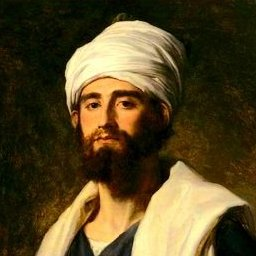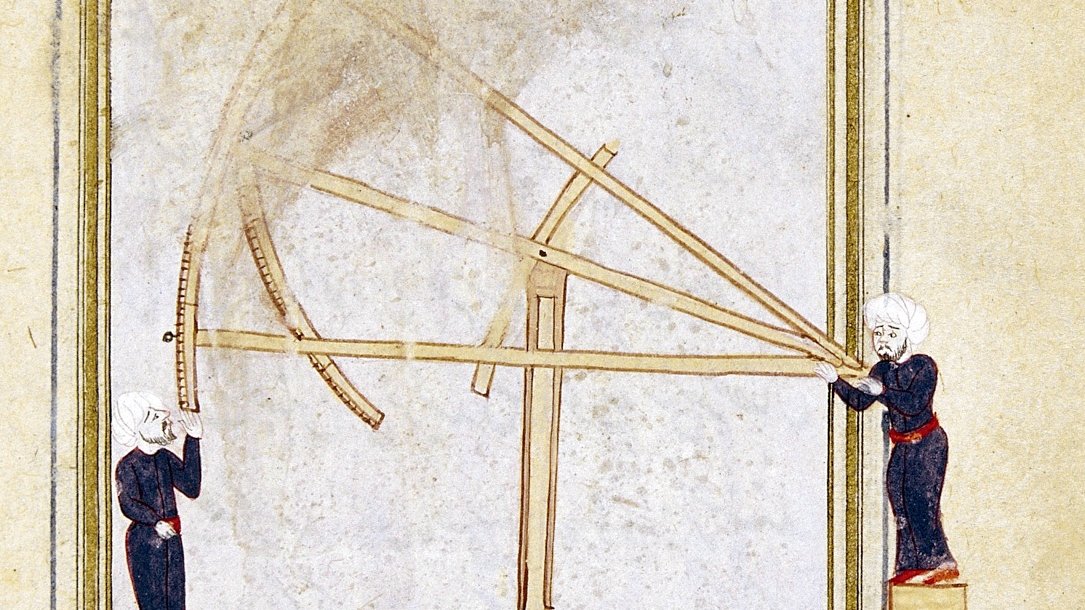
Exploring the wonders of Islamic Scientific Heritage and its timeless contributions to humanity. Join me on a journey through history and innovation.
How to get URL link on X (Twitter) App


 2) Lubna was raised within the Madīnat al-Zahrā palace. She pursued a career within the palace, developing expertise in mathematics, grammar, and poetry. Her responsibilities included managing correspondence and administrative tasks, showcasing her exceptional skills.
2) Lubna was raised within the Madīnat al-Zahrā palace. She pursued a career within the palace, developing expertise in mathematics, grammar, and poetry. Her responsibilities included managing correspondence and administrative tasks, showcasing her exceptional skills. 

 2) Born in 1931 in Indonesia, al-Attas is a Malaysian thinker of Arab descent. Al-Attas introduced the idea of "Islamization of Knowledge," arguing that modern knowledge should be integrated with Islamic values to counter the secular worldview that dominates education.
2) Born in 1931 in Indonesia, al-Attas is a Malaysian thinker of Arab descent. Al-Attas introduced the idea of "Islamization of Knowledge," arguing that modern knowledge should be integrated with Islamic values to counter the secular worldview that dominates education. 


 2) Zheng He was a great-great-great-grandson of Sayyid Ajjal Shams al-Din Omar, who served in the administration of the Mongol Empire and was the governor of Yunnan during the early Yuan dynasty. Sayyid Ajall was a 26th generation descendant of the Prophet Muhammad (P.B.U.H)..2/7
2) Zheng He was a great-great-great-grandson of Sayyid Ajjal Shams al-Din Omar, who served in the administration of the Mongol Empire and was the governor of Yunnan during the early Yuan dynasty. Sayyid Ajall was a 26th generation descendant of the Prophet Muhammad (P.B.U.H)..2/7 


 2) He is best known for writing The Book of Knowledge of Ingenious Mechanical Devices (Kitab fi ma'rifat al-hiyal al-handasiya), ('Book in knowledge of engineering tricks') in 1206, where he described 50 mechanical devices, along with instructions on how to construct them.
2) He is best known for writing The Book of Knowledge of Ingenious Mechanical Devices (Kitab fi ma'rifat al-hiyal al-handasiya), ('Book in knowledge of engineering tricks') in 1206, where he described 50 mechanical devices, along with instructions on how to construct them. 


 2) The main work of al-Mu'taman was his Book of Perfection (Kitab al-Istikmal). This book was a compendium of the Greek mathematics of Euclid and Archimedes among others, but also contained the teachings of Thabit ibn Qurra, the Banu Musa, and Ibn al-Haytham..2/3
2) The main work of al-Mu'taman was his Book of Perfection (Kitab al-Istikmal). This book was a compendium of the Greek mathematics of Euclid and Archimedes among others, but also contained the teachings of Thabit ibn Qurra, the Banu Musa, and Ibn al-Haytham..2/3 


 2) "The book of moderation," was a treatise on general therapy written in his youth for the Almoravid prince Ibrahim Yusuf ibn Tashfin. The book is a summary of various different diseases, therapeutics, and general hygiene...2/3
2) "The book of moderation," was a treatise on general therapy written in his youth for the Almoravid prince Ibrahim Yusuf ibn Tashfin. The book is a summary of various different diseases, therapeutics, and general hygiene...2/3 


 2) These were the first galaxies other than the Milky Way to be observed from Earth. Al-Sufi published his famous Book of Fixed Stars in 964, describing much of his work. Al-Biruni reports that some of his work was carried out in Shiraz...2/5
2) These were the first galaxies other than the Milky Way to be observed from Earth. Al-Sufi published his famous Book of Fixed Stars in 964, describing much of his work. Al-Biruni reports that some of his work was carried out in Shiraz...2/5 


 2)He established several Trigo. identities such as [𝒔𝒊𝒏(𝒂±𝒃)] in their modern form:
2)He established several Trigo. identities such as [𝒔𝒊𝒏(𝒂±𝒃)] in their modern form: 


 2) Abu Kamil made important contributions to algebra and geometry. He was the first Islamic mathematician to work easily with algebraic equations with powers higher than (x^2) up to (x^8) and solved sets of non-linear simultaneous equations with three unknown variables...2/4
2) Abu Kamil made important contributions to algebra and geometry. He was the first Islamic mathematician to work easily with algebraic equations with powers higher than (x^2) up to (x^8) and solved sets of non-linear simultaneous equations with three unknown variables...2/4 


 2) These were the first galaxies other than the Milky Way to be observed from Earth. Al-Sufi published his famous Book of Fixed Stars in 964, describing much of his work. Al-Biruni reports that some of his work was carried out in Shiraz...2/5
2) These were the first galaxies other than the Milky Way to be observed from Earth. Al-Sufi published his famous Book of Fixed Stars in 964, describing much of his work. Al-Biruni reports that some of his work was carried out in Shiraz...2/5 


 2) 2) The number of medical textbooks written by Ibn al-Nafis is estimated at more than 110 volumes. He was appointed as the chief physician at al-Naseri Hospital founded by Sultan Salahuddin al-Ayyubi...2/5
2) 2) The number of medical textbooks written by Ibn al-Nafis is estimated at more than 110 volumes. He was appointed as the chief physician at al-Naseri Hospital founded by Sultan Salahuddin al-Ayyubi...2/5 


 2)He established several Trigo. identities such as [𝒔𝒊𝒏(𝒂±𝒃)] in their modern form:
2)He established several Trigo. identities such as [𝒔𝒊𝒏(𝒂±𝒃)] in their modern form: 


 2) He developed an iterative method for solving cubic equations, which was not discovered in Europe until centuries later. al-Kashi computed sin 1° to nearly as much accuracy as his value for π, which was the most accurate approximation...2/4
2) He developed an iterative method for solving cubic equations, which was not discovered in Europe until centuries later. al-Kashi computed sin 1° to nearly as much accuracy as his value for π, which was the most accurate approximation...2/4 


 2) He belonged to the group of astronomers associated with the Maragheh observatory, most notably Nasir al-Din al-Tusi. In astronomy, Muhyi al-Din carried out a large‐scale project of planetary observations, which led to the development of several new astronomical parameters..2/6
2) He belonged to the group of astronomers associated with the Maragheh observatory, most notably Nasir al-Din al-Tusi. In astronomy, Muhyi al-Din carried out a large‐scale project of planetary observations, which led to the development of several new astronomical parameters..2/6 


 2) Sadr's astronomical work represents an ongoing revision of Ptolemaic astronomy. He undertook to correct the works of two of his predecessors, namely Nasir al-Din al-Tusi and Qutb al-Din al-Shirazi. The models of the last two were developed in their respective works...2/5
2) Sadr's astronomical work represents an ongoing revision of Ptolemaic astronomy. He undertook to correct the works of two of his predecessors, namely Nasir al-Din al-Tusi and Qutb al-Din al-Shirazi. The models of the last two were developed in their respective works...2/5 


 2) Zheng He was a great-great-great-grandson of Sayyid Ajjal Shams al-Din Omar, who served in the administration of the Mongol Empire and was the governor of Yunnan during the early Yuan dynasty. Sayyid Ajall was a 26th generation descendant of the Prophet Muhammad (P.B.U.H)..2/7
2) Zheng He was a great-great-great-grandson of Sayyid Ajjal Shams al-Din Omar, who served in the administration of the Mongol Empire and was the governor of Yunnan during the early Yuan dynasty. Sayyid Ajall was a 26th generation descendant of the Prophet Muhammad (P.B.U.H)..2/7 


 2) He belonged to the group of astronomers associated with the Maragheh observatory, most notably Nasir al-Din al-Tusi. In astronomy, Muhyi al-Din carried out a large‐scale project of planetary observations, which led to the development of several new astronomical parameters..2/6
2) He belonged to the group of astronomers associated with the Maragheh observatory, most notably Nasir al-Din al-Tusi. In astronomy, Muhyi al-Din carried out a large‐scale project of planetary observations, which led to the development of several new astronomical parameters..2/6 

 2) Ibn Jubayr wrote about Saladin. For example, he said, "There is no congregational or ordinary mosque, no mausoleum built over a grave, nor hospital, nor theological college, where the bounty of the Sultan does not extend to all who seek shelter or live in them"...2/5
2) Ibn Jubayr wrote about Saladin. For example, he said, "There is no congregational or ordinary mosque, no mausoleum built over a grave, nor hospital, nor theological college, where the bounty of the Sultan does not extend to all who seek shelter or live in them"...2/5 

 2) Al-Sufi improved upon Ptolemy’s system. Instead of two brightness categories (‘more bright’ and ‘less bright’), Al-Sufi employed three: (‘less’) (‘greater’), and (‘much-greater’). Ihsan Hafez has recorded 132 stars in Al-Sufi’s work not mentioned by Ptolemy..2/4
2) Al-Sufi improved upon Ptolemy’s system. Instead of two brightness categories (‘more bright’ and ‘less bright’), Al-Sufi employed three: (‘less’) (‘greater’), and (‘much-greater’). Ihsan Hafez has recorded 132 stars in Al-Sufi’s work not mentioned by Ptolemy..2/4